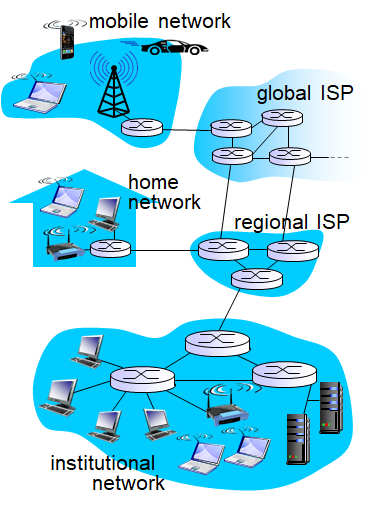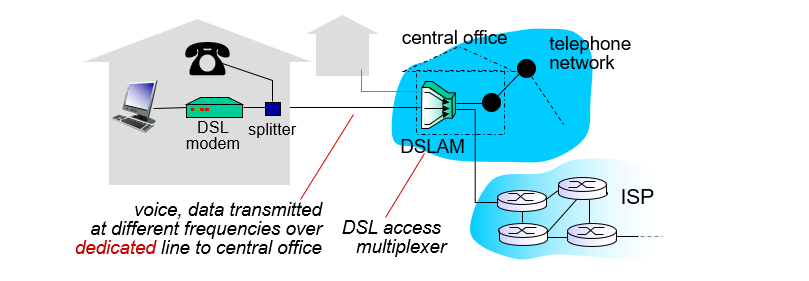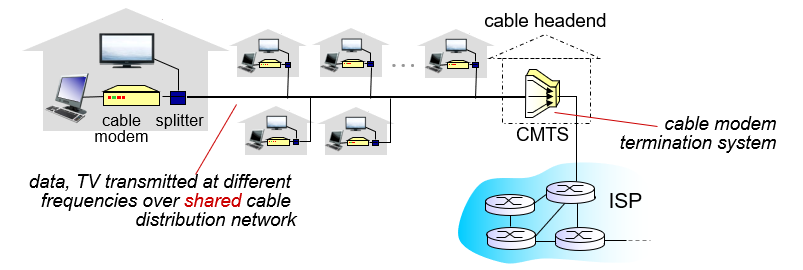What is the internet?
1. Nuts-and-Bolts Description.
- connected computing devices are called hosts = end systems
- running network apps
- End systems are connected by a network of communication links and packet switches
- Different links can transmit data at different transmission rate: bandwidth
- Packet switches: takes a packet arriving on one of its incoming communication links and forwards that packet on one of its outgoing communication links
- types of packet switches: routers and link-layer switches
- route / path:the sequence of communication links and packet switches traversed by a packet from the sending end system to the receiving end system
- Internet service Providers (ISPs): end system access the internet through ISPs.

- Protocols: control sending, receiving of messages
- Transmission Control Protocol (TCP) and the Internet Protocol (IP)
- Internet standards
- RFC: request For Comments
- IETF: Internet Engineering Task Force
2. A Service Description.
A network is an infrastructure that provides services to applications.
- Application Programming Interface (API): specifies how a program running on one end system.
3. What is a Protocol?
- Protocol defines format, order of messages exchanged among network entities, and actions taken on message transmission, receipt.
The Network Edge
- Hosts/ end systems can be divided into client and servers
- host sending function
- breaks into smaller chunks, known as packets of length \(L\) bits
- transmits packet into access network at transmission rate \(R\)
\[ \text{packet transmission delay} = \frac{L}{R} \]
1. Access Networks
a. Home Access
Two most prevalent types of the residential access are Digital subscriber line (DSL) and cable.
- DSL: use existing telephone line to central office DSLAM
- data over DSL phone line goes to Internet
- voice over DSL phone line goes to telephone net
- Cable Network: makes use of the cable television company's existing cable television infrastructure
- Hybrid Fiber Coax (HFC): both fiber and coaxial cable are employed in this system.


b. Enterprise Access Network (Ethernet)
- Local area network (LAN) is used to connect an end system to the edge router.
- End systems connect into Ethernet switch.
- Wireless LANs: Wi-Fi
- Wide-area wireless access: 3G, 4G
2. Physical Media
- bit: propagates between transmitter/receiver pairs
- physical link: what lies between transmitter and receiver
- guided media: e.g. copper, fiber, coax
- coaxial cable: two concentric copper conductors
- fiber optic cable: glass fiber carrying light pulses
- unguided media: radio
- terrestrial microwave (e.g. up to 45 Mbps channels); LAN (e.g. Wi-Fi); wide-area (e.g. 3G cellular); satellite
- twisted pair (TP): two insulated copper wires
Network Core
There are two fundamental approaches to move data through a network of links and switches: packet switching and circuit switching.
1. packet switching
- packet-switching: hosts/end system break application-layer messages into packets
- each packet travels through communication links and packet switches (routers and link-layer switches)
- Store-and-Forward Transmission: the packet switch must receive the entire packet before it can begin to transmit on next link.
- \(d_{\text{end-to-end}}=2\frac{L}{R}\) (assuming zero propagation delay)
- Queueing Delays and Packet Loss
- Output buffer (output queue): stores packets that the router is about to send into that link
- staying in output buffer --> queuing delays
- packet loss: occurs when the buffer is completely full with other packets waiting for transmission.
- Two key network-core functions: routing and forwarding
- routing: determines source-destination route taken by packets
- forwarding: move packets from router's input to appropriate router output
2. Circuit Switching
- Frequency-division multiplexing (FDM): the frequency spectrum of a link is divided up among the connections established across the link
- With FDM, each circuit continuously gets a fraction of the bandwidth.

- time-division multiplexing (TDM): time is divided into frames of fixed duration, and each frame is divided into a fixed number of time slots
- With TDM, each circuit gets all of the bandwidth periodically during brief intervals of time.

- Packet Switching vs. Circuit Switching
- Generally, packet switching allows more users to use network.
- Packet switching offers better sharing of transmission capacity; it is simpler, more efficient, and less costly to implement.
- Circuit switching is more suitable for real-time services

3. Network of Networks
- End systems connect to Internet via accessing ISPs (Internet Service Providers)

- “tier-1” commercial ISPs (Level 3 Communications, AT&T, Sprint, and NTT )
- Content provider network (e.g, Google): run their own network, to bring services, content close to end users
- Internet Exchange Point (IXP): a meeting point where multiple ISPs can peer together.
- regional networks may arise to connect access nets to ISPS
Delay, Loss and Throughput in Packet-Switched Networks
- Delays: nodal processing delay, queuing delay, transmission delay, propagation delay
- Processing Delay: examine the packet’s header and determine output link (where to direct the packet)
- Queuing Delay: time waiting at output link for transmission
- depends on congestion level of router
- Traffic intensity: \(La/R\) (\(R\): link bandwidth; \(L\): packet length; \(a\): average packet arrival rate)
- \(La/R>1\): more "work" arriving than that can be serviced

- Transmission Delay: \(L/R\) (\(L\): packet length; \(R\): link bandwidth)
- Propagation Delay: \(d/s\) (\(d\): length of physical link; \(s\): propagation speed in medium)
\[ d_{\text{nodal}} = d_{\text{proc}} +d_{\text{queue}}+d_{\text{trans}}+d_{\text{prop}} \]
- End-to-End Delay: \(d_{\text{end-end}}=N(d_{\text{proc}}+d_{\text{trans}}+d_{\text{prop}})\)
- Traceroute program: provides {% label warning@delay measurement%} delay measurement from source to router along end-end Internet path towards destination
- Loss: a packet can arrive to find a full queue with no place to store such packet, then a router will drop that packet (aka lost)

- Throughput: rate (bits/time unit) at which bits transferred between sender/receiver
- Instantaneous throughput: rate at given point in time
- Average throughput: rate over longer period of time
Protocol Layers, Service Models
- Layer: each layer implements a service via its own internal-layer actions and relying on services provided by layer below
- Layering modularization can ease maintenance, updating of system
- Internet protocol stack
- application: supporting network applications (FTP, SMTP, HTTP)
- transport: process-process data transfer (TCP, UDP)
- network: routing of datagrams from source to destination (IP, routing protocols)
- link: data transfer between neighboring network elements (Ethernet, Wi-Fi, PPP)
- physical: bits "on the wire" (fiber)
Network Security
- Malware: get in host and infect good stuff into malicious stuffhexo
- virus: §self-replicating infection by receiving/executing object (e.g., e-mail attachment)
- worm: self-replicating infection by passively receiving object that gets itself executed
- Denial-of-Service (DoS): attackers make resources (server, bandwidth) unavailable to legitimate traffic by overwhelming resource
- Packet Sniffer: a passive receiver that records a copy of every packet that flies
- IP spoofing : send packet with false source address